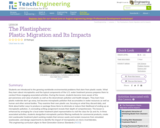
Students are introduced to the growing worldwide environmental problems that stem from plastic waste. What they learn about microplastics and the typical components of the U.S. water treatment process prepares them to conduct three engaging associated activities. During the lesson, students become more aware of the pervasiveness and value of plastic as well as the downstream pollution and health dangers. They learn how plastic materials don’t go away, but become microplastic pollution that accumulates in water resources as well as human and other animal bodies. They examine their own plastic use, focusing on what they discard daily, and think about better ways to produce or package those items to eliminate or reduce their likelihood of ending up as microplastic pollution. A concluding writing assignment reveals their depth of comprehension. The lesson is enhanced by arranging for a local water treatment plant representative to visit the class for Qs and As. In three associated activities, students design/test microplastic particle filtering methods for commercial products, create mini wastewater treatment plant working models that remove waste and reclaim resources from simulated wastewater, and design experiments to identify the impact of microplastics on micro-invertebrates.
- Subject:
- Applied Science
- Engineering
- Life Science
- Material Type:
- Lesson
- Provider:
- TeachEngineering
- Provider Set:
- Lessons
- Author:
- David Bennett
- Sara Hettenbach
- William Welch
- Date Added:
- 06/01/2018
